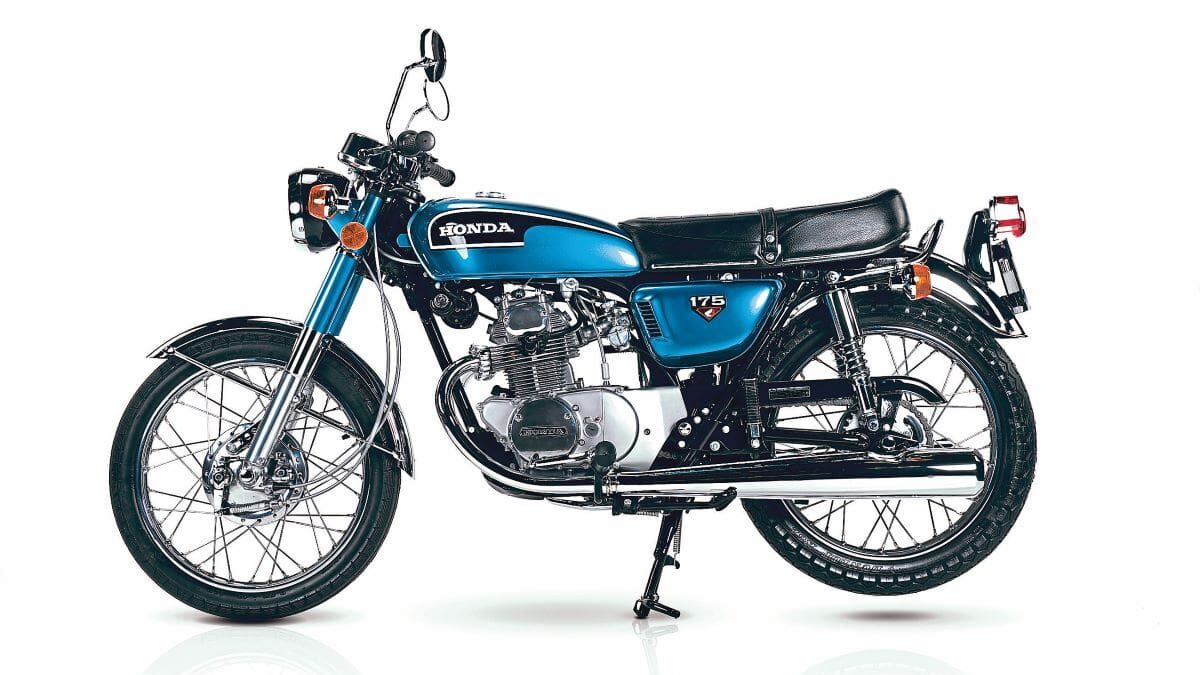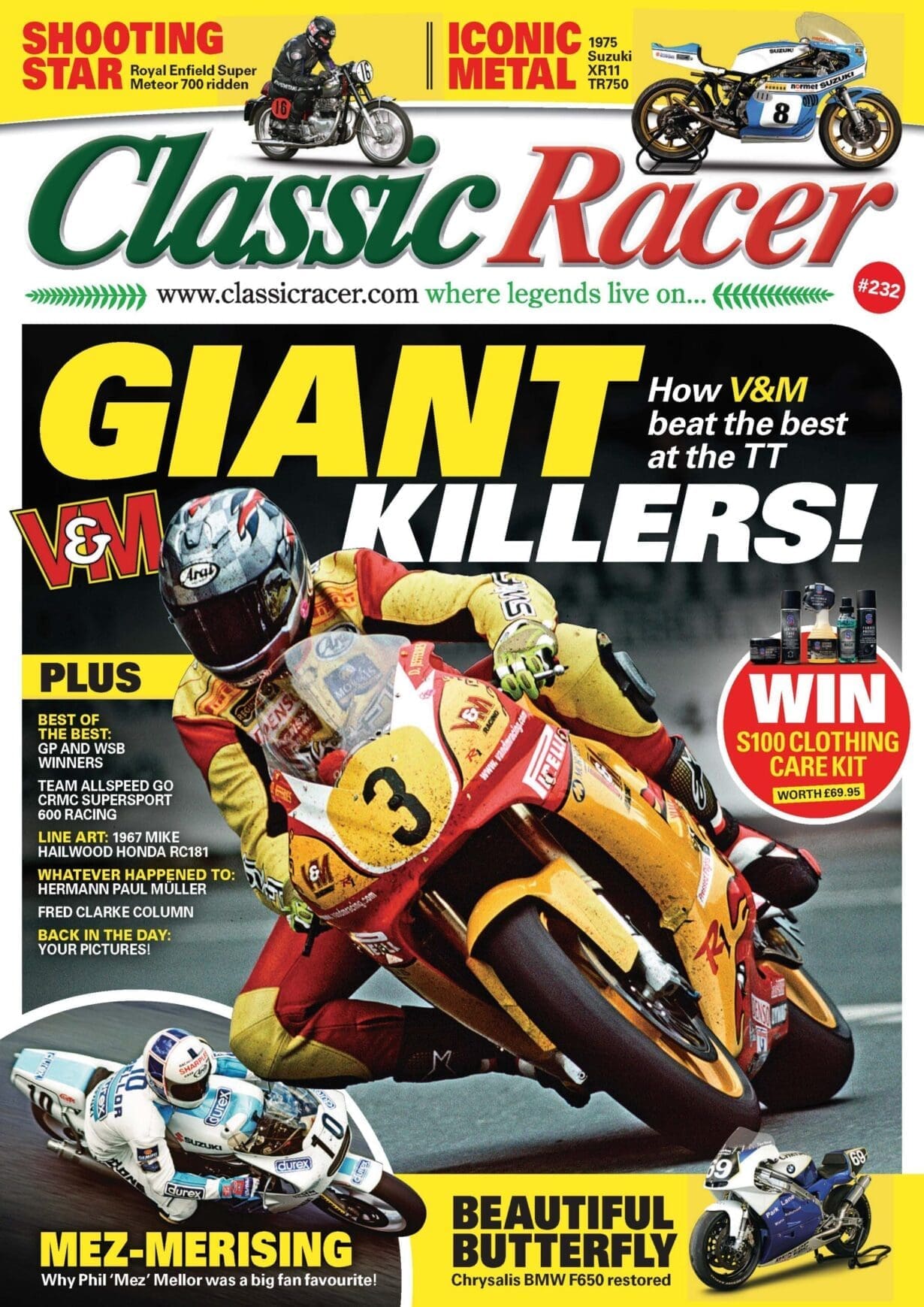This is one beautiful machine – but it’s a replica of one of Honda’s racers, based on the humble CB175 K6. How so?
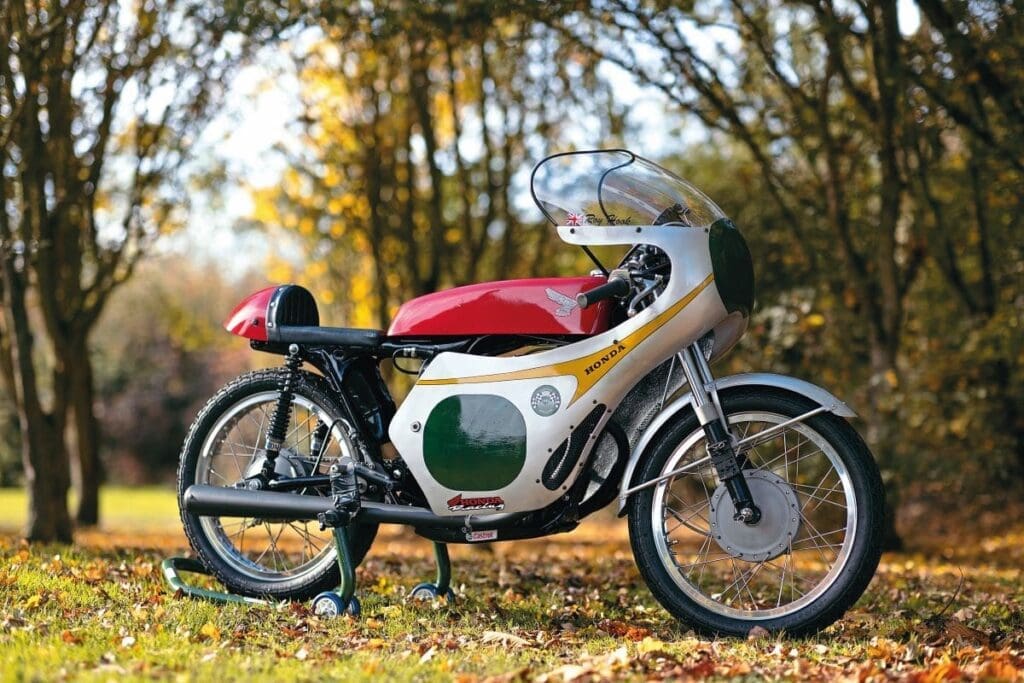
Words: Steve Cooper Pics: Gary D Chapman
The 1960s was a golden period for Honda, where the burgeoning giant from the east demonstrated just what it could design, build and engineer.
The various tiddlers that almost everyone dismissed as being flawed, unreliable, useless and so much more proved to be anything but… much to disgust of the firm’s detractors. The sales of apparently inconsequential step through mopeds to developing nations helped finance better facilities back in Japan which then created larger capacity bikes. The whole thing soon snowballed and helped fund the development of first the sensational CB450 Black Bomber and then the landmark CB750.
As a backdrop to this, the firm had been very successfully utilising road racing as a way to get maximum exposure and PR.
Soichiro Honda had realised that racing success would directly promote his business ambitions and as early as 1959 had bikes competing successfully on the Isle of Man at the TT. Through much of the 1960s Honda’s race bikes dominated competition in most capacity classes – it was a magic formula that further enhanced the company’s standing on the global stage. Huge volume sales of small bikes funded development of bigger machines, while racing successes advertised the brand as a whole.
Very few people in our classic bike world aren’t impressed by the successes of The Big Aitch even if they’re not necessarily fans or customers of the brand. The visual and aural delights of the RC166 250/6 and RC149 125/5 are still breathtaking even 60 years on and, given the opportunity, who wouldn’t want to sample one?
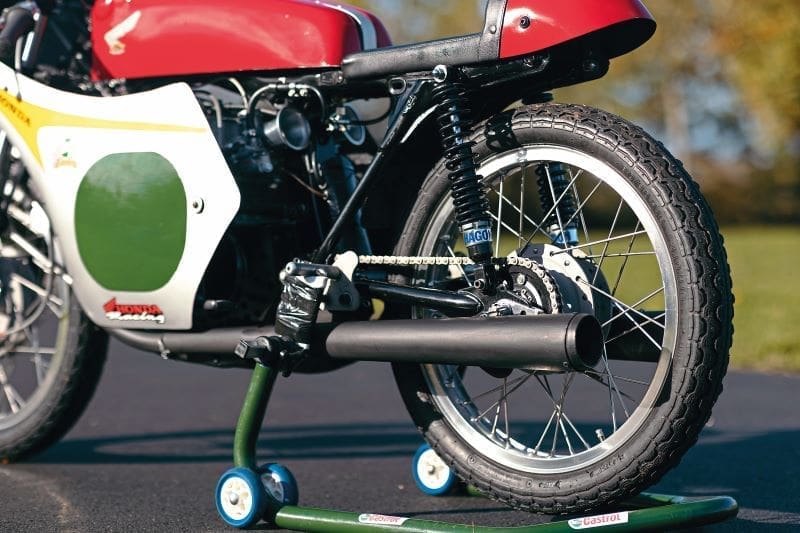

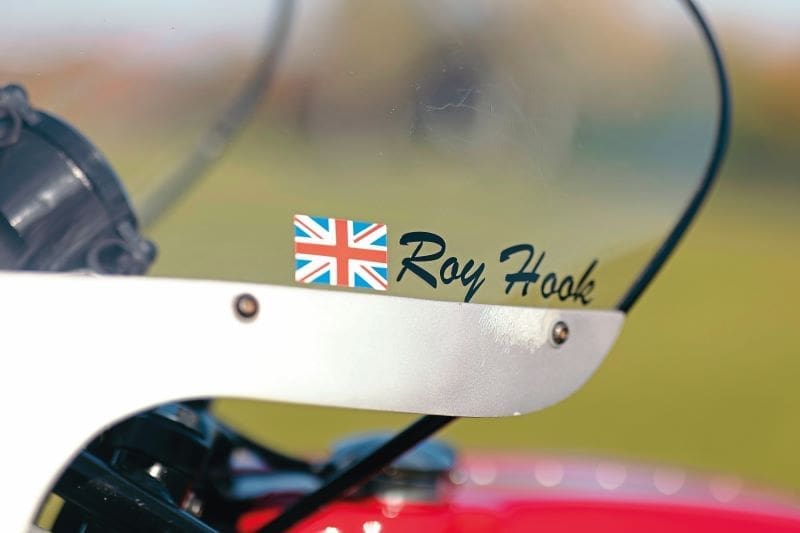
Many have made replicas of the less successful RC181 500/4 using the CB500/4 as a starting point. The single overhead cam motor works well enough for most but a few have press-ganged the double overhead cam CBX550 engine for even greater authenticity in the motor department. For many, such ‘tribute’ machines are as close as they are ever going to get to the real thing.
All of which is marvellous but also involves large wedges of cash. The slightly more cost-effective route for retro Honda race bike replication has always been the use of the CB250/350 K series twins, which have acquitted themselves well in classic racing over the years. However, it’s now generally acknowledged that the development of these road-based racers has peaked – no matter how much money you throw at one you’ll now struggle to significantly improve it. And for owner and builder of our bike in camera, Roy Hook, what he’s created on a semi-sensible budget is frankly spectacular.
With the likes of the bikes of Mike Hailwood, Jim Redman, Luigi Taveri, Ralph Bryans and Tommy Robb as inspiration, the road-based CB175 does a pretty fine job as an imposter. There’s more than a hint of RC166 about it, even if it’s missing four megaphones. The green racing number panel strongly suggests quarter litre capacity even if the capacity is really 174.1cc. In essence what we’re looking at is a SOHC (single overheard cam) facsimile that sits somewhere between those 125cc CR93 over-the-counter racers sold to privateers and the full works spec, made of unobtanium, six cylinder, metal miracles that only a select few were privileged to ride and race.
There’s nothing on the bike that doesn’t need to be there and a few essentials as compelled by both common sense and modern racing track requirements.


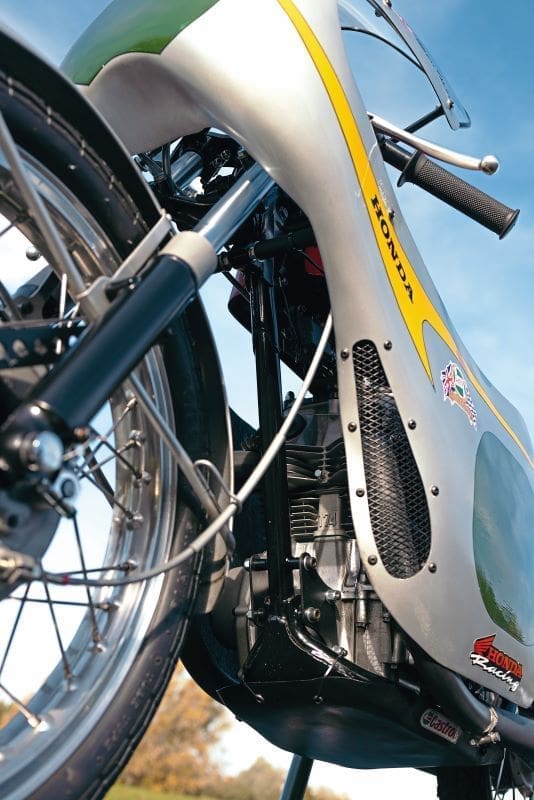
The cockpit contains a Scitsu tacho with warning light for when maximum revs are hit, a toggle switch plus red and green lights for the ignition along with a catch bottle for the breather that comes off the fuel tank.
The fairing mimics that of the period CR92 125s but with two supplementary cut outs that carry wide, expanded, metal mesh. These key additions duct cooling air over the exhaust pipes and help to moderate engine temperatures. Fixed to the lower right fork leg is a holder for now obligatory tracker needed when racing. Performance-wise the bike hasn’t been on a dyno but owner Roy Hook has ridden enough bikes on both road and track to have a good feeling for power. When we pressed him for an estimate of oomph he guardedly reckoned on “north of 22 and south of 25”. Not much up on the Honda quoted 20bhp you may think but hang on. Honda’s figure would have been measured at the crank whereas Roy’s estimation is based on rear wheel feel under CRMC race conditions.
Cost-wise the build came out at around £4000 which, when you read Roy’s overview of what was done, isn’t too scary.
The days of producing any kind of café racer on the cheap are well and truly over and even donor bikes carry a price premium these days.

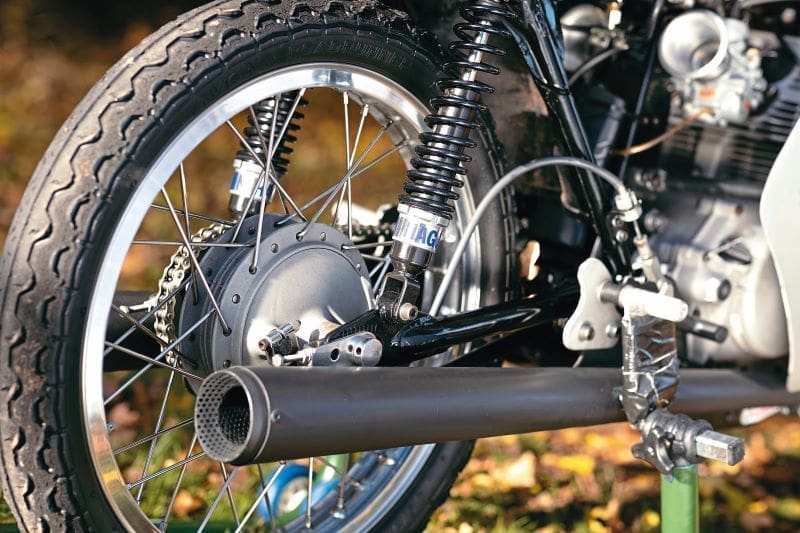
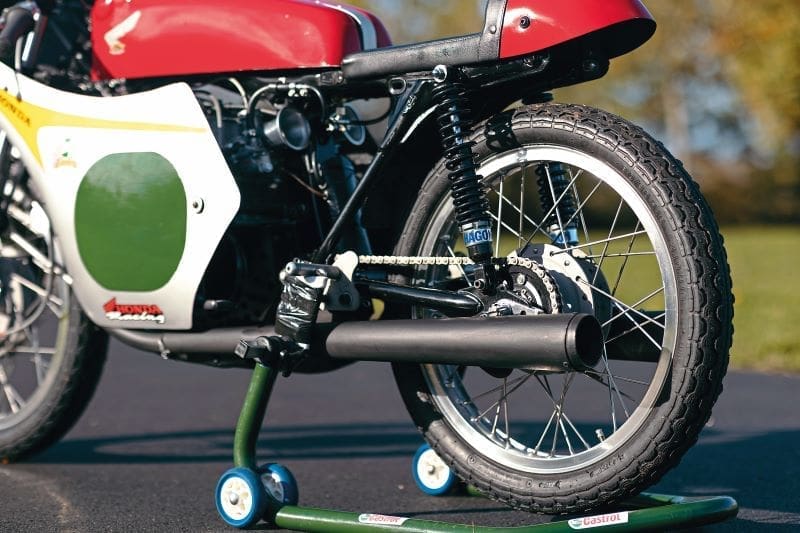
The bike began life a decade ago in Roy’s workshop as a £1750, 28,000 mile, example. Some of that cost could be offset by moving on the parts not used in the Hailwood tribute build but, potentially, it’s a fairly limited market selling parts for the small twin. The end result bristles with the aesthetically correct details. The gloss red tank and seat cowl, that iconic flat silver fairing with the signature yellow flashes, those matt black exhausts … it all looks absolutely pukka.
A tribute bike built on a restricted budget will be always be a half-hearted attempt at best; the CB175-based machine here is anything but. We reckon Messrs Honda and Hailwood would have given this one here their collective seal of approval.
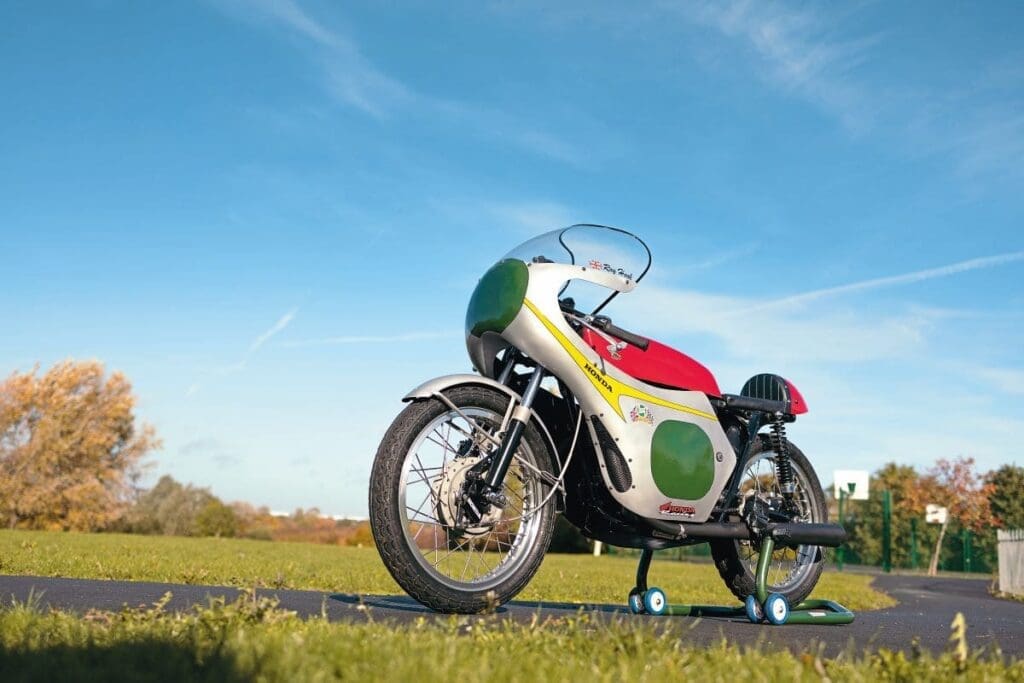
The owner’s view by Roy Hook
“I’d been racing with the CRMC since 2004 on a two-stroke and decided to try four-strokes.
“I’d always liked the fire engine red Honda of the 1960s ridden by Hailwood, Redman etc so thought why not make my own? I chose the CB175 because not many people use this machine for such a project.
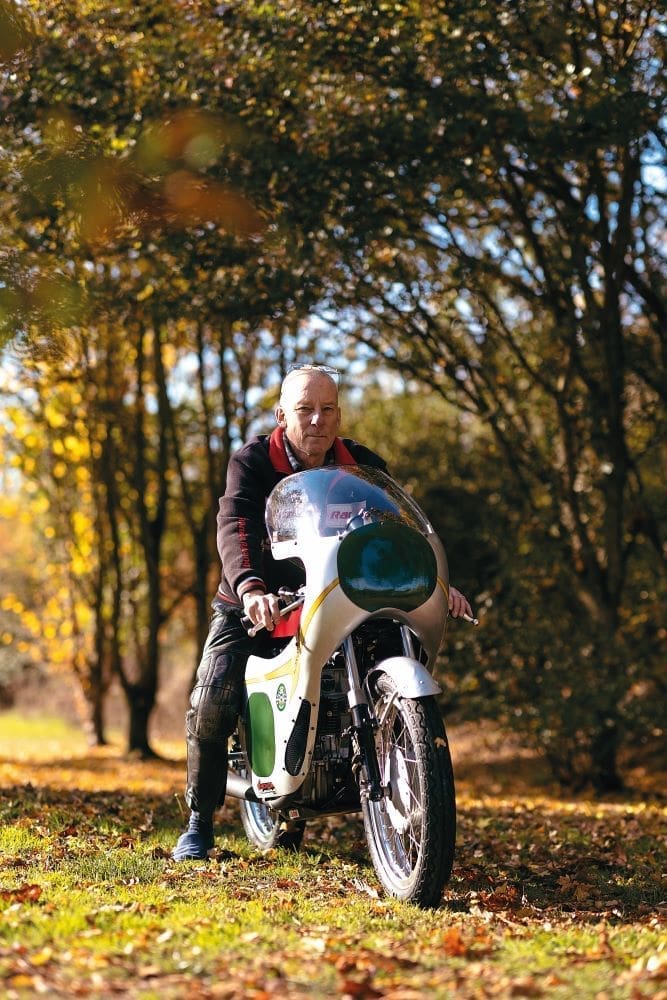
“Having found a complete bike for sale in July 2014 I stripped it back to the bare frame and began its rebuild. With the frame and swingarm left standard I had new alloy rims and stainless spokes built to the hubs by Central Wheels. The brakes were kept standard other than racing linings at the front. Looking to keep everything period I sprayed fork legs black along with yokes. I then had the chrome removed from the front guard so it could be sprayed silver; the rear shocks are Hagon. Both the tail piece and the CR110 tank came from Ragged Edge and are glassfibre; the upholstery was carried out by Motorcycle Seat Works. I did the paint work with rattle cans including the CR93 replica fairing.
“On the motor side the pipes are Swarbrick. Inside the motor, most is standard including the clutch and gearbox but the base circles of the cams were reground to give increased valve lift, the head ported and inlet tracts modified to take 22mm carburettors. The ignition is a self-generating electronic type. I dropped the 520 chain from the K6 175 in favour of a 428 set-up which allows a much better choice of sprockets.
“The bike came together over four years mainly due to sourcing the right parts and getting various components from specialists. Out on the track the bike finished second in 2019 and third in 2020 – both in the CRMC 200cc four-stroke class. It was also awarded Machine of the Meeting at Cadwell in 2019. Overall I’m rather pleased with the little twin.”

The Honda CB175 back story
The Honda CB175 can be traced back to the 1964 CB160 which, in turn, had been created out of the earlier CB95 – an over-bored version of the iconic CB92 Benly.
With larger pistons and some key engine changes including lifting the cylinders to the vertical, the CB175 twin carb was launched in 1969 and remained in production through to 1973/74 before being replaced by the CB200.
Fitted with an electric-start like many Japanese twins above 125 but below 250, the little Honda proved to be both hugely popular and robust. One of the firm’s quirks was the 1968 CB175 which combined the angled cylinder block of the CB160 with elements of the CB175. The bike looked remarkably like a strange mix between the CB160 and the single carb, six-volt, CB175 Sloper. The relative ease of availability of the CB160 (especially Stateside) and CB175 has seen both models used extensively in classic racing. Using 61mm pistons it’s apparently possible to up the capacity to 240cc, which must certainly add some oomph to the small twin. Bikes based around the various 175/200 times would go on to generate Honda huge returns on its original investment. The CD200 Road Master was a huge hit for the so-called emerging nations as late as 2007. Honda even pumped up the design and capacity to a full quarter litre to deliver the huge reliable CD250U, which proved to be another popular commuter machine.
